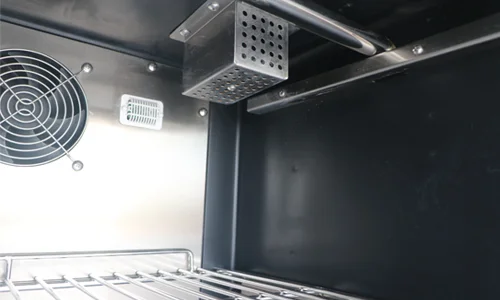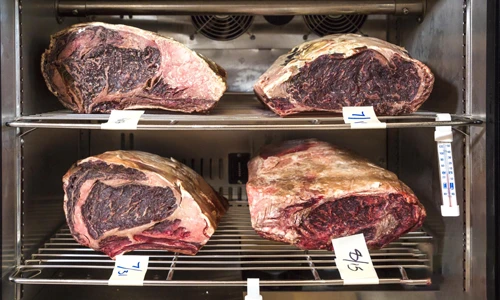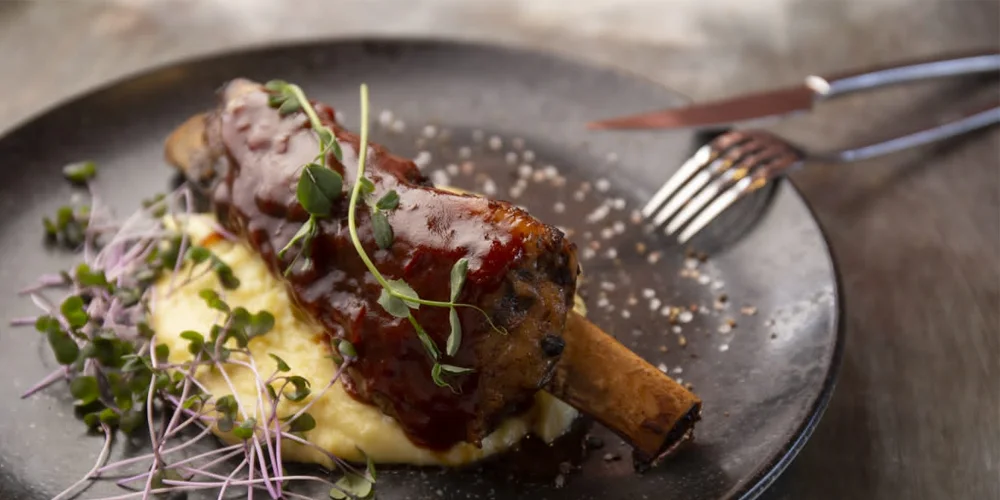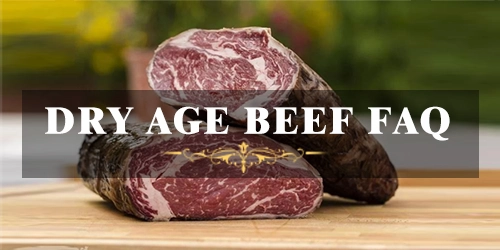Was ist der Unterschied zwischen einem Dry-Age-Kühlschrank und einem normalen Kühlschrank?
Dry aging, a method with roots dating back thousands of years, has been a traditional technique employed by butchers to preserve and enhance the flavor and tenderness of meat, particularly beef. In the evolution of society, the advent of the dry age fridge has played a crucial role in this process. In comparison to traditional aging methods, the aging environment and effects can be meticulously controlled in these specialized fridges, ensuring the safety and sterility of the meat. However, the challenge arises when considering the evident high cost of purchasing a professional meat ager fridge. Can an ordinary refrigerator be used for aging? What sets the two apart? Chefmax is here to unravel the mystery, delving into aspects such as mature temperature, humidity, air circulation, usage, and design.
Temperatur
Consistency in temperature stands as a fundamental requirement for the art of dry aging. This process demands precise temperature management, typically falling within the narrow range of 34°F to 38°F (1°C to 3°C), with control to an impressive ±0.1℃. This specific temperature range optimally fosters enzymatic processes, elevating flavor and tenderness during dry aging. In contrast, standard refrigerators operate with a broader temperature range, commonly set between 32°F and 40°F (0°C and 4°C), suitable for general food preservation. While effective for overall cooling and freshness, this wider range might not create the ideal conditions necessary for the delicate nuances of dry aging, lacking the precision of temperature control found in dedicated dry aging cabinets.
Feuchtigkeit
Maintaining an appropriate level of humidity is paramount during the dry aging process to avoid detrimental outcomes. Excessive humidity can lead to meat rot and the growth of bacteria, resulting in unpleasant odors and diminished meat value. Conversely, insufficient humidity risks over-concentration, compromising the integrity of the muscle structure. Dry age fridge excel in providing optimal humidity levels, typically set between 80% and 85%, striking the delicate balance required for successful maturation. Regular refrigerators, on the other hand, fall short. Operating at a higher humidity, approximately 90%-95%, they hinder the critical evaporation of natural moisture integral to the dry aging process.
Air Volume and Circulation
Maintaining proper air circulation within the aging cabinet is equally pivotal for achieving superior aging effects. Meat ager fridge employ advanced air circulation system designs to ensure a uniform distribution of air around the meat, promoting even aging and preventing mold or uneven spoilage. These specialized refrigerators offer adjustable air volume and precise control over aging conditions. While regular refrigerators have basic air circulation, they lack the tailored design necessary for the unique demands of dry aging. This deficiency introduces uncontrollable factors, potentially resulting in uneven aging and accelerated spoilage in certain areas of the meat.
Application
Dry aging cabinets are purpose-built for the specific task of enhancing the flavor and tenderness of meat through the dry aging process. Their design, functionality, and controls are meticulously crafted to cater to the nuances of this specialized aging method. The controlled environment within these cabinets minimizes the risk of cross-contamination and the introduction of unwanted flavors. In contrast, regular refrigerators prioritize versatility, designed to accommodate various storage needs, including fruits, vegetables, leftovers, and perishable foods. However, they lack the specialized features essential for optimal dry aging, making cross-contamination and flavor transfer potential issues that may compromise the purity of the aging process.
Space and Design
In terms of space and design, meat curing chambers stand out with racks, hooks, and layouts tailored for larger cuts of meat, prioritizing ample space for optimal air circulation. The layout is optimized for the intricacies of complex dry aging processes. Additionally, these cabinets feature separate UVC germicidal lamps, activated carbon filters, and salt bricks to ensure a sterile and odor-free environment for the maturation process. On the other hand, standard refrigerators are compartmentalized for various food items, offering limited space and lacking the specialized features needed for effective dry aging. Their design caters to general storage needs without the precision required for the dry aging process.
Safety issues with dry-aged meat
Addressing safety concerns, dry age fridge provide a controlled environment where whole cuts of meat are placed directly into the cabinet. Specific conditions support beneficial microorganisms and enzyme activity, enhancing meat quality. Mold growth is carefully monitored and controlled through meticulous maintenance. A protective layer typically forms on the surface of matured meat, preventing deterioration and increasing juiciness and tenderness. Ordinary refrigerators, housing a wide variety of foods, pose higher meat safety issues due to potential cross-contamination, exposure to fluctuating temperatures, and inadequate humidity control, leading to faster spoilage and compromising meat quality.


Flavor Complexity
Flavor development is a notable outcome of the controlled aging process in dedicated cabinets, producing a unique and concentrated flavor in the meat. These cabinets ensure that the meat absorbs only the desired properties, with no competing smells from other stored foods. Conversely, regular refrigerators have the potential to absorb various flavors from other stored items, altering the intended flavor of the meat.
The preceding comparison provides a comprehensive understanding of the merits and drawbacks associated with using ordinary refrigerators for dry aging. Numerous tutorials available in the market guide users on utilizing ordinary refrigerators for home dry aging, offering alternatives tailored to specific situations. For instance, if you’re an avid beef lover, experimenting at home is an option. However, improper execution of the process can lead to the loss of valuable beef, leaving you perplexed. In such cases, seeking professional testing becomes imperative, inevitably raising costs. Ordinary refrigerators, lacking precision in control, fall short of replacing specialized dry-aging refrigerators. The heightened risk of bacterial contamination renders the meat inedible. This holds particular significance for establishments dealing with dry-aged meat, such as steakhouses or high-end hotels, where investing in a professional dry age fridge emerges as a truly worthwhile pursuit.



























